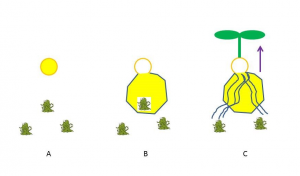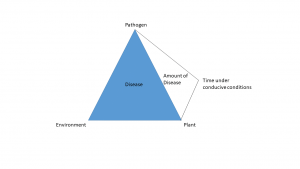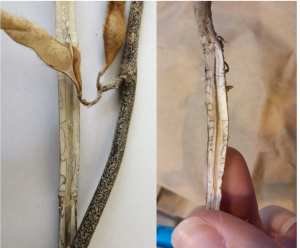After the recent deluge that moved through parts of the state, some Illinois soybean producers have been hit hard with seedling diseases. A common question many people are asking is, “I used a seed treatment, so why am I having problems with seedling diseases?”
Seed treatments are popular in soybean production systems. There are many seed treatments available for managing common seedling diseases in soybeans including Phytophthora, Pythium, Fusarium, and Rhizoctonia. However, seed treatments are not silver bullets for managing seedling diseases. They are useful tools that can help early season emergence issues. This does not mean that using a fungicide seed treatment guarantee that you will not have seedling disease issues. Keep in mind the following:
1) Stand issues can be caused by many things, ranging from compaction, to insects, to planter errors. Obviously a seed treatment will not correct a miscalibrated planter!
2) Seed treatments provide a limited window of protection. Typically they protect the seed, while in the ground, from any nearby fungi that may feed or colonize the seed, and/or protect the newly germinated roots that are produced after germination (Figure 1a). Some fungicide active ingredients simply move to a limited degree in the soil surrounding the seed as they are rapidly locked up by organic matter (Figure 1b). Some fungicide active ingredients may be taken up by these emerging roots and translocated with water to new parts of the growing plant (Figure 1c). As the plant grows the roots eventually either: a) outgrow the zone of protection provided by the seed treatment and therefore roots growing outside of this zone are unprotected or b) as the plant continues to grow systemic fungicides are not translocated to new roots and tissues. In addition, it is important to realize that fungicides to not persist in tissues and soil forever. Microbes, UV rays, dilution effects due to plant growth, water, and organic matter all work to degrade, tie up, and reduce the effectiveness of seed treatment fungicides over time. Thus, a general rule is that seed treatment fungicides will give you roughly 2-3 weeks of protection in most instances. After this time, you cannot expect your plants to be protected from infections caused by seedling diseases later in the season.

3) Some active ingredients only work against specific pathogens. For example, Pythium and Phytophthora are oomycetes, which are not true fungi. Because of differences in their physiology, they are not impacted by many fungicides that target true Fungi, such as Fusarium or Rhizoctonia. Instead, special fungicide active ingredients, such as metalaxyl, mefanoxam, ethaboxam, etc. must be used to against these diseases. Similarly, active ingredients for oomycete control in general are not efficacious against diseases caused by true Fungi.
4) There is limited space on the coat of a seed, and therefore the choice of rate can be very important. Low rates may not be sufficient to control certain diseases in some instances. This is something that is especially true in the insect world, where some insects require higher seed treatment rates to achieve sufficient control.
5) You could have disease because you planted a highly susceptible variety, and compounded the issue by planting into a situation that favored pathogen growth. This would include planting into cool, moist soil into a field with a field with a history of seedling disease.
6) The environment didn’t favor seedling disease development until later in plant growth. This goes along with what I mentioned in point #2. Perhaps there was a span of wet weather a month after planting? Your seed treatment has lost it’s effectiveness by that point, leaving the plant open for infection. Seed treatments are not soil fumigants. They will not wipe out all the pathogens in the soil.
It is easy to blame a seed treatment for seedling diseases, but hopefully you can see that the issue is far more complex than what you may think. Seedling disease management is not straightforward, and producers should be utilizing all the tools available to ensure quality stands and maximum yields. This includes avoiding continuous soybean production, reducing issues with drainage, planting into warm moist soils, avoiding planting with storms forecast in the immediate future, and planting quality seed with varieties that have high tolerance or resistance to diseases of importance. Lastly, as I always say, disease management starts with accurate identification of the pathogen. Images are often not sufficient to properly identify a disease, and many issues can mimic diseases. For example, severe waterlogging and compaction can cause wilting and symptoms similar to seedling diseases. Consequently, if you are unsure of the issue you should send it to the UI diagnostic clinic. They can conduct a range of tests, from growouts, to ELISA, to PCR, to confirm the pathogen, if any exist.


